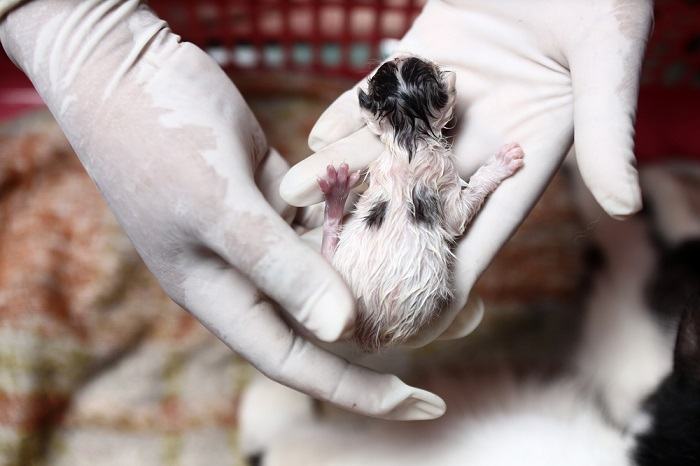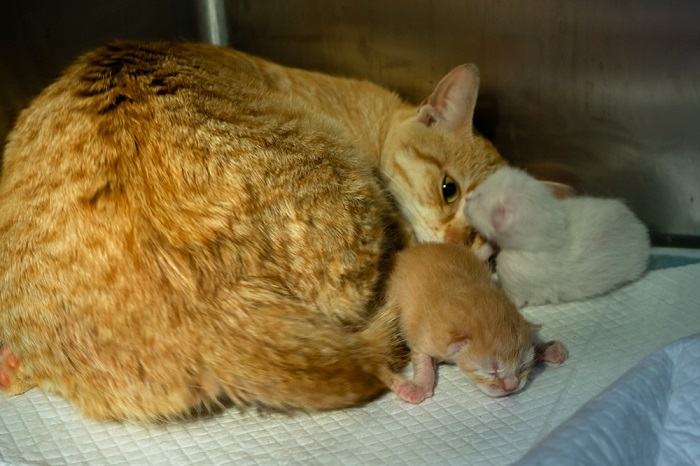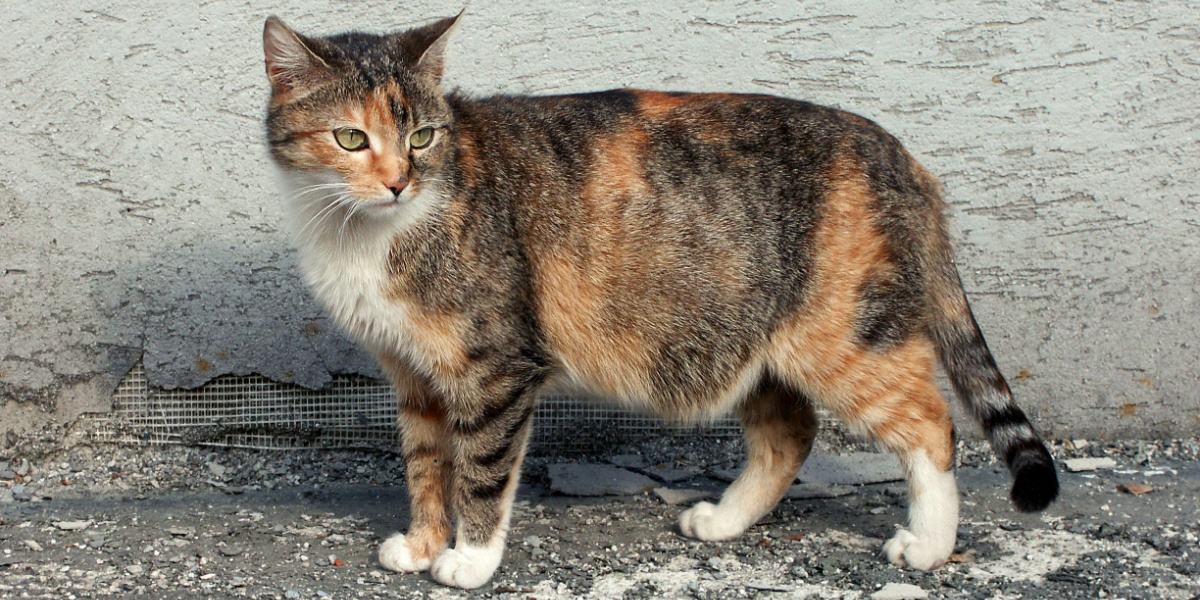
The aim of this article is to provide clear, easy-to-understand information about what happens when a cat suffers from dystocia (difficulty giving birth to kittens). Dystocia in cats is common and can be life-threatening if not treated properly. Read on to learn more.
Quick Overview: Dystocia In Cats (Difficult Birth)




What Is Dystocia in Cats?
Dystocia is the term that describes a difficult birth. The term is derived from the Greek words “dys,” for “difficulty” and “tokos,” meaning childbirth. This is an obstetrical emergency that needs urgent veterinary attention to save the lives of the cat and her kittens.
How Common Is Dystocia?
Dystocia is rare in cats. The vast majority (94 – 97%) of cat pregnancies and parturitions are completely normal, with dystocia occurring in 3 – 6% of cases.
Obviously, it is not a risk at all to spayed female cats. And of course, it is not a problem for non-pregnant female cats. Most pregnant cats give birth naturally, with no need for intervention.
But when a cat has difficulty passing kittens, this is an urgent emergency. Everyone who cares for a pregnant cat should learn about this potential issue, and it is useful for others to know this as part of general knowledge of pet health.
Dystocia can affect all domestic cats but is more common in pedigree breeds such as Siamese, Persian, British Shorthair, and Cornish Rex cats. This is partly because they are more likely to be kept for breeding. Dystocia is also more common in obese cats, and in older cats.
How Do Cats Get Dystocia?
When pregnant queens undergo the birthing process (also known as parturition), they strain to push newborn kittens out of the uterus, through the vulva, into the outside world. If, for any reason, this process does not happen smoothly and quickly, this is classified as dystocia.
The causes of dystocia are most commonly caused by maternal factors (i.e. issues caused by the mother cat), and are far less commonly caused by fetal factors (i.e. something to do with the kittens).
Maternal factors include uterine inertia (the uterus does not contract normally), narrowed birth canal (either as a natural anatomical feature, or following an accident such as a broken pelvis), an obstructed birth canal (e.g. a tumor, abscess, or other swellings), stress (especially in first-time mothers), obesity, and any other general disease that makes the cat unwell generally.
Uterine inertia can happen for various reasons, including exhaustion if there is a large litter, inadequate stimulation of the uterus if there is a small litter, stress, and low blood calcium levels. Other reasons are possible as well.
Fetal factors include oversized kittens, congenital abnormalities of kittens (so that they may not be as streamlined as normal), and malpresentation (e.g. kittens coming out in positions other than the normal, streamlined, head- or tail-first).
What Are the Normal Stages of Giving Birth in Cats?

Most cats give birth to their litter within six hours of the process, from beginning to end.
There are three stages of labor in cats and it’s important to monitor a cat giving birth very closely so that you are aware of the stage that is happening to your cat. These stages are as follows:
- The first stage lasts around 4 – 24 hours. The changes at this stage are not directly observable, because they are happening internally: the cervix (opening to the womb) dilates, the uterus begins to contract, and the cat starts to show changes in their behavior. This includes meowing, anxiety, restlessness, nesting, and going to a quiet area where they can be on their own. If the rectal temperature of the cat is taken at this stage, it will be found to be lower than normal.
- The second stage is the actual delivery of the kittens into the world. A clear vaginal discharge is observable, along with abdominal contractions, and the cat visibly straining to pass the kittens. The first kitten is usually passed within 60 minutes of this straining commencing, and after that, each following kitten is usually passed within 30 – 60 minutes. Most queens have completed kittening within six hours.
- The third stage is passing the placenta, afterbirth, and other membranes, after the kittens. This usually happens within fifteen minutes of each kitten being passed. Each kitten has its own placenta, attached to the kitten by the umbilical cord, and the mother cat normally separates these by nibbling through the cord.
Often a cat will pass from stage two to stage three, repeatedly, as each kitten is passed followed by the membranes and other tissues associated with that kitten.
After the third stage, the kittening is complete, and the cat will stop straining and will settle down to feed her newborn kittens.
What Are the Signs of Dystocia?
The most common rule of thumb is that if a cat is in the second stage of labor (straining to pass a kitten) for over sixty minutes with no progress, then they are suffering from dystocia. This means that they urgently need to be taken to the vet.
Dystocia is often defined more comprehensively to include a number of other possible scenarios when urgent intervention is needed, as follows:
- A prolonged pregnancy: when kittening does not happen as expected at the normal time at the end of the gestation period. This is nearly always between 52 and 74 days (the average is 65 – 66 days) from the last day that they were mated. So if a cat has not produced kittens after 74 days, this can be defined as dystocia.
- A prolonged interval between the birth of kittens (more than 4 – 6 hours) even if the cat is not actively straining.
- The second stage of labor lasts over 24 hours (i.e. the entire process is not fully completed after a full day).
- Part of a kitten (or a visible fetal membrane) protrudes from the vagina for over 15 minutes without progress, despite the cat straining.
- The presence of a green discharge without a kitten being passed within 15 minutes.
Diagnosis of Dystocia
The signs of dystocia are so obvious that an immediate visual broad diagnosis is easy to make. You simply need to take the cat to the emergency veterinarian as promptly as possible. They will take over and do everything necessary to look after your cat and her kittens.
Your veterinarian may take the following actions.
1. Detailed History Taking
As in every veterinary case, your vet will discuss every aspect of your cat’s life and health care. This will include asking questions about the cat’s reproductive history (when the cat was in season, when mating took place, etc.), and recent habits (eating, drinking, passing urine and feces, etc).
They will also ask you for precise details on what you have noticed happening to your cat in the previous 12 – 24 hours. For example, did you notice a behavioral change, see a vaginal discharge, was the cat straining, etc.
2. Physical Examination
Your veterinarian will check your cat over carefully. They will carry out an obstetrical examination and check your cat’s general health at the same time. Often this physical examination is sufficient to give the vet enough information to decide on an immediate action plan. Sometimes a more detailed workup may need to be carried out.
3. Routine Blood Tests
Your veterinarian may suggest blood tests. These include the usual panel of diagnostic tests, such as hematology (blood count) and biochemistry profiles. These tests confirm that there is no other underlying issue that may be contributing to the dystocia.
4. Diagnostic Imaging
X-rays may be taken, and an ultrasound examination may be carried out. These will establish more precise details about what is going on (e.g. number or position of kittens, narrowed pelvic canal, and any other abnormalities in the abdomen).
5. Specialized Blood Tests
Rarely, a progesterone assay may be carried out. If there are questions about the stage of the pregnancy, it might be necessary (e.g. in a cat that has gone over the normal duration of gestation).
Treatment of Dystocia

Most cats give birth naturally, without the need for help or intervention.
There are three possible courses of action when a cat is suffering from dystocia.
1. Manual Removal of the Kittens
In simple cases, it may be possible to manually manipulate malpositioned kittens into a more streamlined position. With plenty of lubrication, the kittens may be able to be physically pulled out of the cat. In practice, this is rarely the case.
2. Medical Intervention
In some cases, a cat may be suffering from low calcium levels in the blood. This contributes to poor contractility of the uterine muscles. Intravenous infusion of calcium is recommended to treat this, and sometimes this is enough to solve the problem.
In other cases, an injection of a hormone called oxytocin is recommended. This is a natural hormone produced by the cat’s body in response to the kittens stretching the vaginal canal and by them suckling the mother’s nipples.
Oxytocin induces stronger uterine contractions. If the vet judges that this will be helpful, they will give a subcutaneous or intramuscular injection of oxytocin. This needs to be used with care. If oxytocin is given to a cat that has dystocia because of an obstruction in the birth canal, there is a risk of rupture of the uterus.
3. Surgical Intervention
A surgical operation to remove the kittens from the uterus (a cesarean section) is necessary in 50 – 60% of cats with dystocia. The cat is anesthetized, and a surgical incision is made in the midline of the underside of the abdomen. The uterus can then be surgically opened, and the kittens removed directly.
Often, the cat will be spayed (an ovariohysterectomy) at the same time, although if she is a breeding female, the owner will discuss this option with the veterinarian beforehand. The surgical wound is then closed, and the cat is allowed to regain consciousness.
Sutures are placed after this procedure. They may need to be removed around ten days after the surgery.
4. Additional Treatment
In all cases of dystocia, ancillary treatment, including pain relief and intravenous fluid therapy for shock, is likely necessary. Careful nursing, management, and observation are important. This includes ensuring that kittens are accepted and feeding normally, and that the mother cat is urinating and defecating normally. A hot water bottle helps ensure that the mother and kittens are warm enough. Regular checking of the mother cat’s body temperature is important.
Diligent monitoring is necessary. Checking for the signs of metritis (a uterine infection) and checking the mammary glands to ensure that there is a plentiful milk supply is important. Lactation (the production of milk) is critically important to newborn kittens.
Prognosis for Cats With Dystocia
Most cats make a good recovery after treatment for dystocia. The key to good outcomes is obtaining treatment as promptly as possible. The risk of complications and potential fatalities is higher if dystocia is prolonged.
If the reason for the dystocia was maternal factors (such as a narrowed pelvic canal) then it is very likely that the same issue will recur if she becomes pregnant again. This is why spaying is recommended at the same time a cesarian section is carried out.
Dystocia involves a serious risk to the lives of the kittens, with mortality rates varying significantly. Again, prompt attention optimizes the chances of kittens surviving, and diligent after-care is also very important.
Prevention of Dystocia
The best way to prevent dystocia is to spay female cats before they become pregnant.
Final Thoughts
Dystocia is one of the risks for a cat that is going to have kittens. All owners of pregnant cats need to be aware of this risk. Familiarize yourself with the steps to resolve this serious problem.
Also Read: Why Do Cats Scream When Mating?
Frequently Asked Questions
What to do if a cat is having trouble giving birth?
If a cat seems to be in difficulty giving birth, you absolutely need to seek veterinary help, urgently. The longer a cat is left in difficulty, the greater the risk to her life and to the lives of her kittens.
Why is my cat having a hard time giving birth?
There are many reasons why a cat can get into difficulties when giving birth, and it is impossible for a cat carer to work out what is happening by just looking at a cat. That is why you need to get proper veterinary assistance.
How do you get a stuck kitten out?
While it is possible to gently pull on a kitten that is protruding from a cat's vulva, it is easy to do more harm than good. It is usually far more complicated than it seems: it's rare for such a situation to be easily solved with a simple gentle tug. Veterinary skills are usually needed.
How common are birth complications in cats?
Around 94 - 97% of kitten births happen naturally without problems, and around 3 - 6% (roughly one in twenty) develop complications that need assistance.
How long is too long for a cat to be in labor?
The most common rule of thumb is that if a cat is in the second stage of labor (straining to pass a kitten) for over sixty minutes with no progress, then they are suffering from dystocia and they urgently need to be taken to the vet. Other guidelines are as follows. Intervention is needed if:
+ Kittening does not happen as expected at the normal time at the end of the gestation period. So if a cat has not produced kittens after 74 days, help is needed.
+ There is a prolonged interval between the birth of kittens (more than 4 – 6 hours) even if the cat is not actively straining.
+ The entire process is not fully completed after a full day.
+ Part of a kitten (or a visible fetal membrane) protruding from the vagina for over 15 minutes without progress, despite the cat straining.
+ A green discharge is seen from the vulva without a kitten being passed within 15 minutes.








I really love this family.As a Veterinary medical students there are a lot of information to learn about cats here.I hope I am welcome 🙂